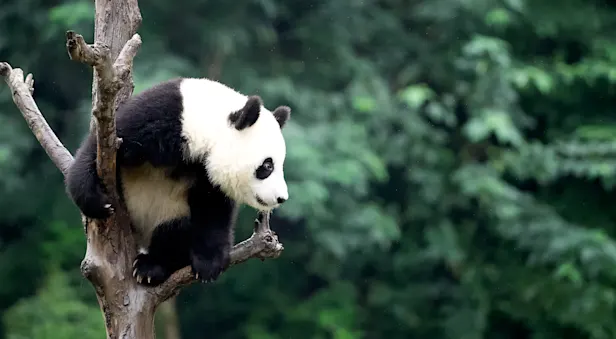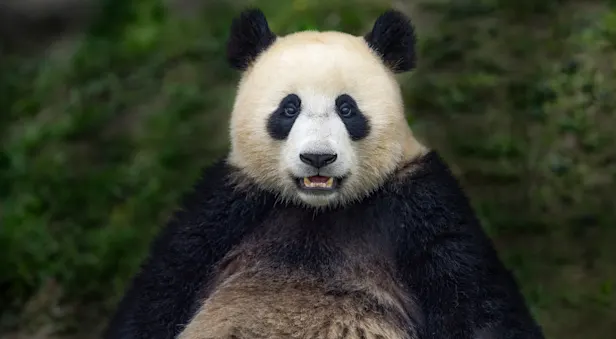Red Panda Facts | China Wildlife Guide
Red pandas are the sole living species of the family Ailuridae and genus Ailurus. The species was originally labeled a Procyonidae with raccoons, ringtails, and other omnivorous mammals with long tails due to similar anatomy, behavior, and reproduction. They were then placed in the Ursidae family of bears because they shared common DNA. However, their specialized foraging patterns and Asiatic geographic distribution are distinct enough to warrant their own separate family.
Physical Characteristics
Red pandas resemble raccoons, possessing a round head with white badges, a pointed snout and erect ears. Their long, bushy tails have a distinctive pattern of twelve alternating red and buff rings. These creatures are about 42 inches long and weigh between six and fourteen pounds. Their coat has two layers; an outer covering of coarse guard hairs, and a soft, wooly undercoat.
Males and females look relatively similar. Their white face has ruddy tear markings, which run from their small eyes to their throat. The pelage on the red panda’s upper body is reddish-brown, while its undersides and legs are a lustrous black. The soles of its feet have a dense covering of white fur. The forelegs of a red panda are angled inward, resulting in a waddling walk.
Geographic Range & Habitat
There are two subspecies, A. f. fulgens and A. f. styani. The western red panda, Ailurus fulgens fulgens, is found in Nepal, northeastern India, Bhutan, and western China. To the east, Styan’s red panda inhabits the East Nujiang River in Yunnan Province and the Hengduan Mountains in Sichuan Province, and northern Myanmar. The red panda once ranged over the Chinese provinces of Guizhou, Qinghai, Gansu, and Shanxi. However, it has since become extinct in these regions and is now found only in Yunnan, Sichuan, and Tibet. There are an estimated 14,000 square miles of suitable habitat left in China for red pandas.
Red pandas inhabit temperate deciduous and coniferous forests at altitudes of 5,000 and 13,000 feet. They feed on the forests thick bamboo and find shelter in the forests hollow trees.
Feeding Habits
Bamboo leaves are the red panda’s primary food source. The red panda will grasp and bow the bamboo with its forepaw to bring the leaves to mouth-level. Plant material is sheared with the red panda’s sharp teeth. The red panda eats about 30 percent of its body weight in food daily to maintain a healthy weight. Like giant pandas, red pandas are unable to efficiently digest cellulose, forcing them to consume a large volume of bamboo, and spend up to 13 hours eating each day. The low metabolic rate of a red panda, similar to that of a sloth, helps them conserve energy. When not feeding, they spend much of their time in a sedentary state, retaining body heat with their thick fur coat. Red pandas supplement their low-calorie bamboo diet by foraging for blossoms, berries, eggs, birds, acorns and seeds, and sometimes even mushrooms, insects and small mammals.
Behavior
The behavior of a red panda varies throughout the year according to climate, the abundance of food, and the presence of cubs. These normally solitary creatures are nocturnal and are most active between dusk and dawn.
Red pandas are arboreal and spend most of their time in trees when they’re not foraging. They move from branch to branch, and gracefully descend from trees headfirst. The red panda uses its bushy tail for balance when climbing. After eating or sleeping, red pandas stretch, give themselves a thorough cleaning, washing their face with their paws, and rubbing themselves against a nearby rock or tree.
Red pandas use body movements to communicate with one another. These include staring, arching the back and tail, moving the head while puffing or jaw-clapping, and standing on hind legs with forepaws held above the head. When afraid or aggressive, a red panda will take up a bipedal stance and make hissing spits or snorts. If threatened, it may also climb a tree or strike out with its semi-retractile claws.
Breeding
Red pandas become sexually mature at approximately 18 months of age. Adult males and females typically only come together during the breeding season, which occurs between early January and mid-March. During this time males will urinate or rubbing their ano-genital area on trees. Females invite the males to mount them on the ground. Delayed implantation occurs, and the gestation period lasts approximately 134 days.
Six weeks before delivery, females grow heavier and more lethargic. In the days preceding labor, the female gathers grasses, leaves and sticks for her nest, crafting a resting place in a cave or hollow tree. Births occur throughout the spring and summer, with most cubs arriving in June. Litter size ranges between one and four newborns. Births occur between 4 pm and 9 am, during red pandas’ most active hours.
Red panda young weigh between three and five ounces at birth. Females have olfactory memory and can recognize their young by the odors they emit directly after birth. After the first week, the mother spends less and less time with her young, returning every couple of hours to nurse and groom her cubs, in addition to keeping the nest tidy. Fathers play little to no role in rearing their offspring.
The cubs remain nest-bound for 90 days, at which point, they take their first steps out of the nest. The mother shares a close bond with her young until the start of the next mating season when they become aggressive. Pandas are weaned at about 12 months, when they reach adulthood. The maximum lifespan for a captive red panda is 17 years of age, but the average is 8 to 10. The average lifespan in the wild is unknown.
Conservation
The red panda is a rare species, whose numbers continue to decline. Deforestation is the primary threat to the red pandas’ survival. Habitat fragmentation from logging and agriculture have resulted in the loss of bamboo and threatened their numbers. Red pandas are also hunted, and cubs are sold in the illegal pet trade. The red panda is an endangered species and is protected under their listing in Appendix I of CITES, the Convention on the International Trade in Threatened and Endangered Species.
Header Credit: Justin Gibson
See Red Pandas on These China Adventures

The Wild Side of China: A Nature Odyssey
Discover a side of China most travelers never see on our unique itinerary revealing wild panda habitat, rare wildlife and Chinese nature at its most entrancing—including close-up panda encounters.

























